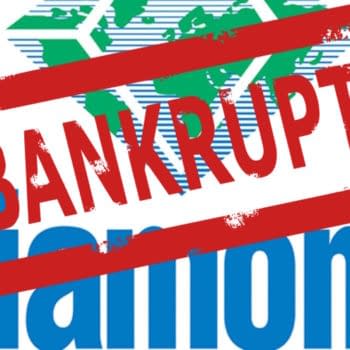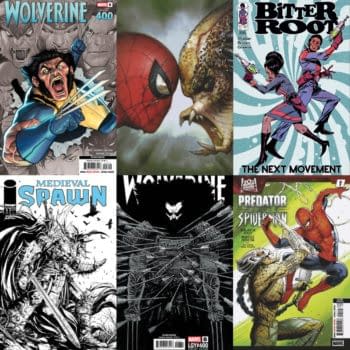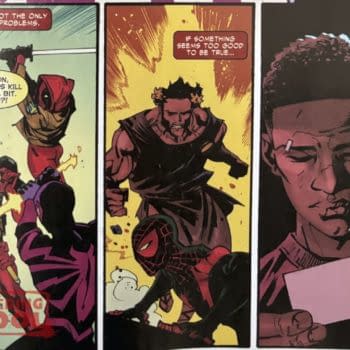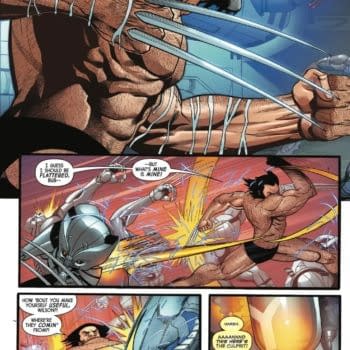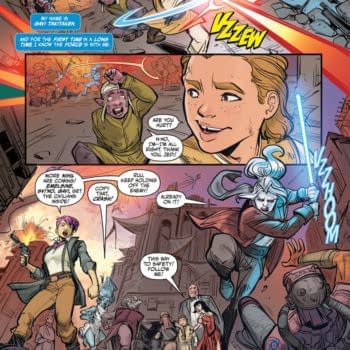Posted in: Comics, Recent Updates, Speculator Corner | Tagged:
Making A Packet Out Of Paperbacks – Ryan Lee

Ryan Carstensen supports his comics buying habit by selling trade paperbacks (TPBs) and hardcover collected editions at multiples of their initial cost. Carstensen goes by the moniker of Ryan Lee as co-host for the notoriously humorous comic book podcast Chronic Insomnia. Each week he is joined by co-host, Michael LaMere where the duo discusses topics such as seminal output, flatulence and their feigned disdain for Canadians. In addition, Carstensen offers cogent analysis of the comics industry. The chief component that separates Chronic Insomnia from their broadcast peers is Carstensen's segment, Market Spotlight. Here he offers recommendations and shares data regarding his ongoing business venture as a 'trade flipper.'
Bleeding Cool: How long have you been collecting?
Once upon a time in 1982 my mother gave me $1.00 to spend at a Ben Franklin store, and I bought Uncanny X-Men # 163. I've been in love with comics as a storytelling medium ever since.
In late 2005 I went digging for price information on Pre-Unity Valiant books on eBay and noticed a Prince Valiant trade reprinting the old newspaper strips that sold for over $100. My jaw dropped. I had always equated TPB with reprint, and thus 0 value. I started digging through all the completed sales on trades and saw a copy of Wonder Woman: Challenge of Artemis that popped for $40, and I knew that the book market had arrived.
What was the first book you flipped for profit?
The first one I can remember was a copy of Thor Visionaries: Walt Simonson Vol 2. Bought it for $16 and sold it within 48 hours for $80.
What's your big fish story?
I think the most I've ever sold a book for was a Fantagraphics Prince Valiant Vol 35 for $240. There's a real price resistance at around the $50 mark, and an even stronger one around $100. I do most of my work buying things at the $10-15 range and selling them in the $30-$50 area. I can remember finding a perfect copy of the Star Wars: Empire's End TPB for $3 and flipping it for $79.99, and that's a pretty good margin!
What are some perennial TPB titles you gravitate towards?
I'll tell you what makes me smile – when I walk into a convention or a Half Price Books and I see a giant stack of older Batman and Nightwing trades. I've made a killing on Batman trades like Last Arkham, Strange Apparitions, Blind Justice, Prodigal, Dark Legends, Joker: Devil's Advocate. I think most people would be shocked at how many Nightwing TPBs are profitable, even buying at cover price. Top of the heap for Nightwing continues to be Vol 2: Rough Justice. Nothing is easier to flip than an out of print Batman trade; price it reasonably and it's gone.
Weird stuff you wouldn't think of as high dollar like DCs Resident Evil Collection or Thundercats: The Return have done very well for me because they don't stand out as marquee names. The TPB game is not about popularity; it's about connecting a niche audience with a scarce item.
Approximately how many transactions will you conduct in a given month?
I do about 500 transactions a year, or 40 a month. The summer months are the slowest, and I have to adjust prices down a bit to make anything happen. November and December are awesome. We're talking at the end of September, and with a week left I've sold 33 books for a total of $997 after Amazon's cut. That's about average, and I'll do better than that (as much as double that) as we get closer to Christmas. It isn't enough to make a living on, but it's no joke, either.
Just generally, I think the 1994 Marvel Limited hardcovers are all gems. One book I've always wanted but have never been able to obtain for a decent price is the Predator Vs. Magnus Robot Fighter TPB. That book is tough.
Why don't more people understand the commerce of TPBs/HCs? People have always looked at single issues. How has the market changed?
Most people don't "get it" because there's no available price guide to shortcut the market for them. I think most people who went through the early 90s consider any kind of profit-by-comics as dirty business, so they aren't looking for opportunities, and would likely punch you in the face if they knew you were doing it. I still think the vast majority of comics collectors still think of value as coming from the Silver Age and older, and consider trades as reprints with no collectible value. I think the key to all of this is a paradigm shift where a growing number of comics readers prefer to get their material in book form. When I grew up, a TPB was a copy of the "real thing". That stigma against collected material is largely gone now.
Explain the concept of "timing" and how important it is in maximizing your profit while leveraging against deflated value potential.
The big difference between investing in floppies and investing in trades is the deadly phenomenon of going back to press. Remember that Thor Visionaries Vol 2 I sold for $80 back in the day? You can't do that anymore. Marvel went back to press on the book, and it instantly killed the profit.
If you have a copy of say, Amazing Spider-Man # 129 with the Punisher's first appearance, it is slightly susceptible to outside forces. The Punisher could get more or less popular, or the market could shift away from the Bronze Age and into Copper material. It could happen. But wild swings are rare.
If I can sell a nice copy of Spider-Man: Origin of the Hobgoblin for $40 today, (and I can) but Marvel comes out with a new edition tomorrow – poof! – my profit just went bye-bye, instantly. The reason being that the collected book market is very much a reading market. Nobody buys my out of print trades because they think they'll sell it for more later. They buy my books because they desperately want that material in book form and can't get it anywhere else. If that material becomes available again, they will go to the cheaper new edition with a smile.
So when you're in the trade game, you have to extraordinarily conscious about how much you pay for an item and what books are coming down the pipe, because if it goes back to press you are no longer getting multiples of cover price.
Let's play the Futures market. What do you like long term?
I really love the Marvel Classic Library collection. I'm talking about the direct market editions with the comics on the cover and the print run listed on the back. It's all great material and I'm already seeing that start to pop. Try and find Vol 9: Iron Man Demon In A Bottle. You can't do it. I like all those books.
I think the big story right now is Marvel's inability to reprint those Alan Moore/Neil Gaiman Miracleman stories. I think the consensus opinion has been that it's just a matter of time before they go back to press on that, and it's keeping prices on the Eclipse books relatively low.
But Marvel Comics is not a company to leave a nickel on the table. The fact that they aren't printing that material tells me that they can't. If they can't get that legal hell squared away, I think those Miracleman books go boom in spectacular fashion, and now might be your last window to get those items without spending thousands.
I also believe that the trade market will mature into something that recognizes them as collectibles, and when that happens, first prints will mean something. I think a discerning collector cherry-picking near mint copies of classic stuff like Sandman, Y The Last Man, or Walking Dead will be very happy they did so in a decade.
The game is also changing in that as more product hits the market with lower print runs, the time between release date to out-of-print profit is shrinking. I just sold a copy of IDWs Classic GI Joe Vol 7 for $40. I bought it for $16 when it first hit the stands about twelve minutes ago. When I first started doing this, the bulk of what I selling was from the late 90s. Now I routinely make profit on books less than a year old. That tells me that there is either something wrong with the way the product is released or kept in print.
Some people frown upon your Market Spotlight financial aspirations. What are their reservations and what are your thoughts on detractors?

The difference, though, is that I'm not advocating overprinting or gimmicks. And if you listen closely, you'll notice that what I do is not speculation. It's very rare that I make a call on something that might be profitable down the road. What I do is reaction, not speculation. I watch what the market does, and as it favors a book I say "you have window on this book right now." And that window is there because people want to read the material, so I don't see how that's bad for the industry. We ran into trouble when folks were buying stacks of overprinted books they had no intention of reading. That's not a behavior I'm feeding into.
If you're asking if I ever feel guilty about buying a book for $8 and selling it for $60…no, I don't. And my buyer doesn't feel bad about the hours of research I flushed building the knowledge that allowed me to do that. Nor should they. I enjoy putting in the time, and my knowledge pays me a pretty good wage. It's the American Way, and there's no real moral quality to it from my perspective.
Tell us where to find Chronic Insomnia.
If you're interested in getting into The Game, I distill my research into the Market Spotlight segment of the Chronic Insomnia comics podcast. If you listen to our show, I can promise you a couple of things. You're going to laugh your bum off, and you're going to get at least three ideas that will make you money if applied. A price guide, even if one existed, really wouldn't help you, because the market shifts and things go back to press. Your best bet is to either do a ton of research, or listen to our show and let me do it for you!
We have new shows available every Tuesday, and you can find us at chronicinsomnia.podbean.com or the Comics Podcast Network!
Carstensen regularly publishes comics reviews and editorials at http://chronicinsomniashow.blogspot.com. His articles represent his passion for the hobby, strong writing chops and a twisted sense of humor.







